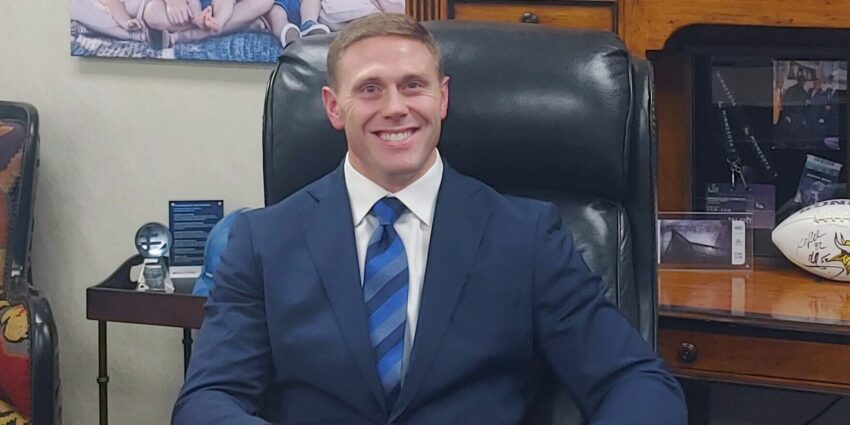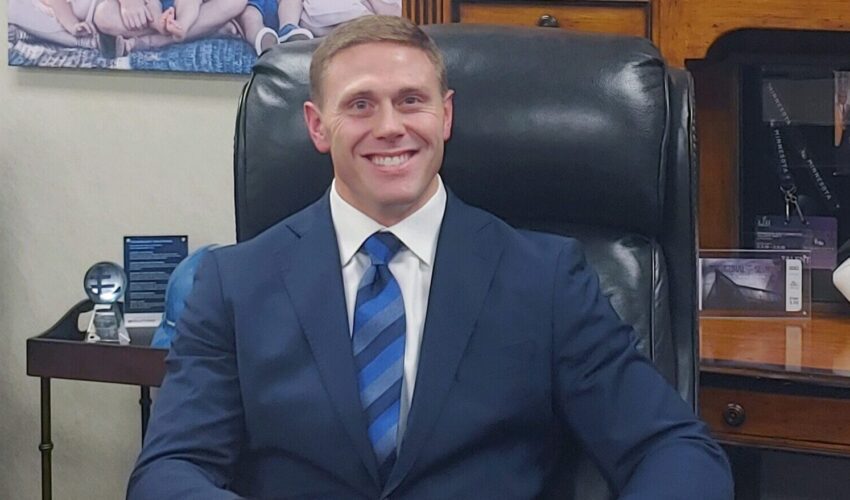One-on-one with Sanford’s new CEO: Gassen talks merger, pandemic, future focus
Dec. 14, 2020
“Our patients, our people and our communities.”
Bill Gassen repeats it like a mantra.
The newly named CEO of Sanford Health repeats it when talking about why he named the individuals he did to his leadership team two weeks after he assumed the position.
He repeats it when explaining why the system suspended its potential merger with Intermountain Healthcare days after he became CEO following the departure of longtime CEO Kelby Krabbenhoft.
He repeats it again when talking about his approach to the COVID-19 pandemic, which has ravaged the Dakotas in recent months as Sanford, the largest provider in a two-state area, has noticeably changed its messaging under Gassen’s leadership.
“What’s extremely important to me and important to this organization is that we have a very crisp focus and reprioritize ourselves moving forward,” he said.
“It’s a new day at Sanford. And reflective of that new day is our reprioritization around every single thing we do at this organization.”
Gassen, 40, came to Sanford in 2012 as a corporate counsel. He holds a bachelor’s degree in criminal justice and a law degree, both from USD.
Two years later, his career brought him into the people side of the organization when he joined the human resources department and eventually became chief human resources officer. Last year, he was promoted to chief administrative officer, overseeing HR, technology solutions, legal, facilities, business development and the Sanford Sports Complex.
The lawyer in him uses an example of other business deals in explaining the situation around a proposed merger with Utah-based Intermountain Healthcare.
The deal announced in late October was at the phase of a letter of intent, he said.
“I explain to people that back when I was practicing law, that if there were 10 off-ramps between introduction and LOI, then there were 100 off-ramps between LOI and (a deal finally coming together). That’s the important time. You’re doing due diligence, having conversations about organizational structure and priorities, and going through a regulatory process. That’s why you see more often than not that those deals don’t go forward – because there are so many reasons to step aside.”
The decision to suspend the merger has “very little to do with the potential merger partner and instead has everything to do with Sanford Health,” Gassen said. “The need that this organization has to reprioritize our efforts, our energy, our resources around our patients and our people and our communities. And in order to do that, we have to focus on those areas. We have to focus on Sanford Health and concentrate on our needs right now. It’s the only decision we could make and be right for our people and our patients.”
While it wasn’t a light decision for leadership or the board of trustees, “it was an easy decision because of where we needed to prioritize our energy,” he said. “I have much respect for Intermountain, (CEO) Dr. Marc Harrison and his leadership, but this was not the right merger for us at the right time.”
The proposed merger, which would have moved the organization’s headquarters to Utah and made Sioux Falls a regional corporate office, drew quiet but pointed feedback from community business leaders. Multiple sources acknowledged there was outreach to Sanford that voiced concerns, which Gassen confirmed.
“There were feelings that were shared with us that could be best described as concerns, uncertainty, what does it mean for our communities,” he said. “Since the announcement was made for us to suspend indefinitely those conversations, we’ve received a very positive response from our communities, from our providers, from our employees. I would attribute that simply to their support of what we’re prioritizing and focusing on right now.”
He also has spoken with namesake philanthropist Denny Sanford within the past week. While Sanford “never overtly antagonized the potential merger, he affirmed … in the conversation that he agrees with and supports the direction we are moving now,” Gassen said.
“He’s extremely respectful about allowing the organization and its board to make whatever decision they thought was best.”
The overall conversation was a “very positive one,” Gassen added.
“He’s enthusiastic about the new leadership team, enthusiastic and supportive about the new direction, the new day here at Sanford and extremely supportive of our reprioritization of our patients, our people and our communities. For people who might be wondering whether his support of this organization and all the good we’re doing and will do in the future, if that was unique to a leadership team or individual, I would just want them to know and thank him for his support for the amazing work that we are able to do at Sanford Health. Through and with philanthropy like his and many of our other donors, that’s going to continue.”
The difference between Sanford’s proposed merger and other business deals is that most aren’t made public at the stage of a letter of intent. Health care deals requiring regulatory approval take a different path, which includes public disclosure at an earlier point in the process. For Sanford, that also has meant a public airing as deals have unwound – Intermountain this year and a proposed deal with Iowa-based UnityPoint last year.
Getting to that point was tied to Krabbenhoft’s growth strategy, rooted in the belief that health care organizations would need to achieve a certain scale to remain leaders in the years ahead. He pointed to the thinking of Mike Leavitt, former governor of Utah, who served under President George W. Bush as secretary of the Department of Health and Human Services.
Leavitt, who has championed health care consolidation as a way to improve patient care and system financials, was the one who introduced Krabbenhoft to Harrison in a move that ultimately led to the proposed Intermountain merger.
The former Utah governor was slated to join Sanford’s board before chairing the combined board post-merger. That’s no longer happening.
“Certainly in health care, like many industries, size and scale can be advantageous. But it has to be the right size, the right scale and at the right time,” Gassen said.
“I think that growth will continue to play a role in the development and advancement of this organization. It will not be the only strategic imperative for us.”
There are other ways to grow that could look different, he added.
“What are the other ways we can shore things up for our communities and providers and patients that may not require a full asset merger? There may be things we can do, contractually or unique investments. We need to make this organization allow us to better serve those patients and our people and our communities. It will still have a place at the table. It won’t be the only place at the table.”
In the short term, there’s still a pandemic to manage. This week, Sanford and others will begin administering the first vaccines for COVID-19.
Before Krabbenhoft’s departure, an all-staff email made national headlines after he shared his experience with COVID-19 and told his team he would not be wearing a mask at work because he considered himself unable to transmit the virus.
Under Gassen, Sanford’s external communications have included its employees masking, messaging around masking and photos of Gassen – who has had COVID-19 – wearing a mask.
“I think what happened is that we didn’t let the voice of our providers come through strongly enough,” he said.
“For a long time, Sanford avoided putting its weight behind a mask mandate because we thought that should be left to policymakers and to individuals in our communities to step up and do the right thing. I want to be clear: We’ve always been in support of masking, but the environment started to change this fall with the surge, and we had many of our own people calling on the system to get behind a mandate. It became apparent that simply allowing free choice wasn’t effectively getting the job done.”
Given the situation throughout the system’s medical centers, supporting a mandate is the right thing to do, he said.
“We need to own some of that criticism for not taking a stronger stand on it sooner. Since I took on this role, I’ve said that it’s a new day at Sanford, and my commitment to our people and to our communities is that they’re going to see and feel the difference.”
The strain on front-line health care workers also played a role in his decision to announce his leadership team so shortly after becoming CEO, he said.
While much of the team appointed by Krabbenhoft remained, the main personnel changes involved a new chief physician and chief nursing officer.
“We owe it to them (front-line caregivers) to bring stability, bring certainty and (support) their overall well-being,” Gassen said. “We have to control what we can control, and this is what we’re able to control, so we owe it to them.”
Again, he repeats it: the focus is on the system’s patients, people and communities.
And, put even more directly:
“What Sanford Health needs right now is to focus on Sanford Health.”








